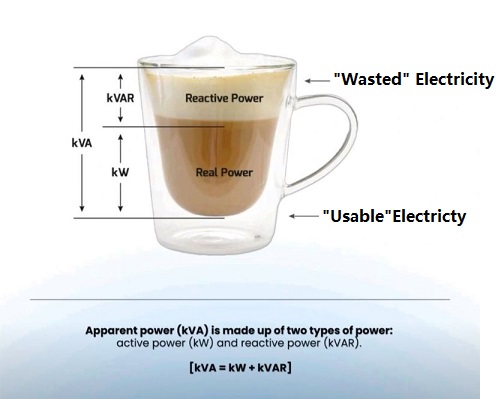Many people get confused by these three power terms:
kW (Active Power)
kVAR (Reactive Power)
kVA (Apparent Power)
Let’s clarify them using a vivid analogy that engineers love。

kW – The Espresso
kW represents the real work done — the part of electrical energy that is actually consumed and converted into mechanical power, light, or heat.
For example:
Driving motors
Powering equipment
Lighting systems
This is like the espresso shot in your cappuccino — the “real substance” you’re after.
kVAR – The Foam
kVAR is reactive power. It doesn’t do any actual work, but it’s essential for establishing magnetic fields in inductive loads like motors, transformers, and compressors.
It’s like the foam on your cappuccino:
It doesn’t give you that caffeine kick directly (no real energy transfer)
But without it, you couldn’t even brew the coffee!
kVA – The Full Cup
kVA is apparent power. It’s the total power your electrical system must deliver, including both active and reactive components.
Just like when you order a cappuccino:
You’re getting the espresso
Plus the foam
Your transformer, generator, or UPS must be rated for this “full cup,” not just the part you actually drink.
The Power Triangle: Not Simple Addition
Many people mistakenly think:
kVA = kW + kVAR
That’s incorrect.
The real relationship is:
kVA² = kW² + kVAR²
This forms a right triangle, and the power factor (PF) is:
Power Factor PF = kW ÷ kVA = cos(θ)
So kVA isn’t just the sum of espresso and foam — it’s a vector sum, like in the Pythagorean theorem.
Why Power Factor Matters
If you have too much foam, your coffee won’t be strong enough. In your electrical system, that’s:
Low Power Factor
More foam (reactive power), less espresso (active power)
Increased current, voltage drops, higher losses, oversized cables, and possible utility penalties.
High Power Factor
Less foam, more espresso (more real power, less reactive)
Efficient power delivery, properly sized equipment, and reduced energy costs.
Summary
You’re not just buying an espresso — you’re getting a whole cup of coffee.
Similarly, your system isn’t just delivering kW; it must handle the entire kVA.
Smart engineers know how to size the cup correctly and manage the foam to keep systems efficient and cost-effective.
Let me know if you’d like to add more technical context or tailor the tone further for a particular audience — always happy to help!